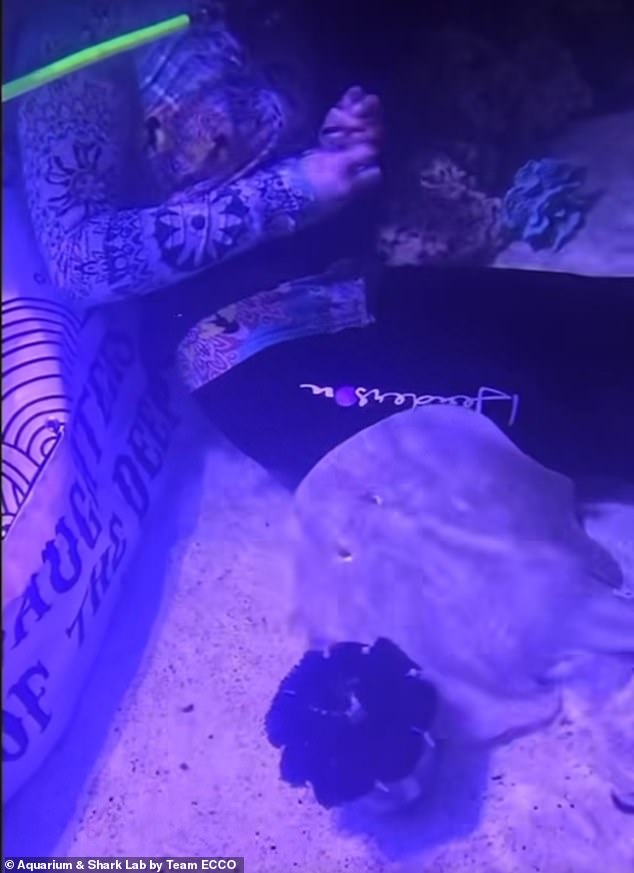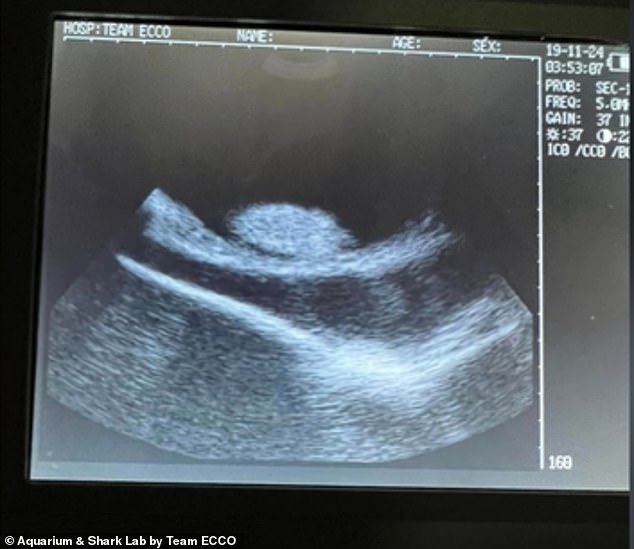North Carolina Aquarium provides update on Charlotte the virgin stingray’s pregnancy after experts fear her babies could have died
Relief. Charlotte the Virgin Stingray’s babies are doing well and she is still due to give birth at any time.
This is evident from the latest update from the North Carolina aquarium team that cares for her.
Team ECCO’s Aquarium & Shark Lab posted on Facebook and Instagram that the stingray and her pups are in good health following the results of the latest ultrasound.
The aquarium’s announcement this weekend came in response to continued public pressure for more information about the pregnant stingray’s condition – with some experts even speculating that her unborn young may have died.
The skepticism stems from the aquarium sharing the first news of the pregnancy in February – and two months have passed with no changes.
Charlotte the stingray is expected to give birth soon, but due to the unusual nature of her pregnancy, experts cannot say when that will be.
But the announcement has done little to allay suspicions among some observers.
In the absence of details, rumors are circulating.
Charlotte became the center of a media frenzy in February when Team ECCO announced that she was pregnant – despite not living near male stingrays.
Charlotte the stingray and her unborn babies are in good health, according to the latest update from Team ECCO’s Aquarium & Shark Lab in Hendersonville, North Carolina, where she has lived since 2016.
But while the new announcement shared on Facebook assured the public that Charlotte is doing well, it did not include any new details about her condition or which experts were consulted.
Team ECCO did not respond to multiple requests for comment from DailyMail.com.
In the months since Charlotte’s immaculate conception was announced, some observers have become concerned that the aquarium is not communicating clearly with the public, leading some to suspect something is wrong.
Team ECCO’s updates are sporadic and don’t always contain much specific information about Charlotte.
Some experts have expressed frustration that Team ECCO has refused input from other aquarium professionals.
Team ECCO has even blocked some aquarium professionals who reached out privately, according to one commenter.
“I think those of us who haven’t been blocked have simply given up trying to slow down the confusion and disinformation,” wrote Linsdsey Condray, who lists her occupation as a senior aquarist at the Henry Doorly Zoo and Aquarium in Omaha, Nebraska.
“The way this aquarium handled Charlotte’s case was not to follow standard procedures for handling a pregnant ray. There’s no information on where they sent the latest ultrasounds, but so far they’ve made it pretty clear that they don’t want help from other experts.” she wrote.
And some members of the general public have become conspiratorial, speculating that the animal is being abused and that aquarium officials are lying about its status.
Be that as it may, Team ECCO announced that the expectant mother is doing well.

In a video posted to Team ECCO’s Facebook page, Charlotte is shown being fed by a diver in the aquarium. Aquarium staff assured the public that they and the developing babies are healthy.

Certain animals can reproduce through ‘facultative parthenogenesis’, where the egg is fertilized with cells from the mother rather than by a male.
‘Here’s Charlotte’s Saturday update! We are still patiently waiting for Charlotte to be born,” the update began.
‘The ultrasound we sent to our colleagues looked good and there were no signs of any discomfort.
‘We will share new developments as they occur.
‘This has been an incredible journey and we thank you for following along! Your support inspires us to continue our research on Elasmobranch Parthenogenesis.”
‘Parthenogenesis’ is the term for an animal that essentially fertilizes itself, using her own eggs to create a genetically complete clone in the absence of males of her species.
It has not yet been confirmed that parthenogenesis is the cause of her apparent virgin birth, but it is the most likely explanation, as she has not seen a male of her species in almost ten years.

Charlotte, seen in February. She has reportedly never shared an aquarium with a male of her species, but the aquarium said she was pregnant. It’s scientifically possible, but there isn’t much precedent for such an occurrence.

Researchers say Charlotte’s ultrasound shows she is carrying four pups, but the aquarium has not shared any details.
In March, the aquarium shared ultrasound images of Charlotte’s developing babies.
The video showed them moving their tails, and experts said she was carrying as many as four pups.
Because her virgin birth is so unusual, the aquarium has not been able to tell the public exactly when she will give birth.
This has led to rampant speculation on social media.
“Isn’t it long past time to have her checked by a certified veterinarian?” This is getting to the point of neglect and possible abuse,” one commenter wrote on the post.
Others reflected a similar skepticism: ‘When will a vet be called in to REALLY check her out? Who were the results sent to and can you post the results as they sent them to you? The first article I saw about this mentioned bumps were noticed in September 2023…..she is now said to be 8 months pregnant……’
And indeed, the aquarium said they started monitoring her in 2023 because of the bumps.

Charlotte, the pregnant virgin stingray, is seen swimming around her aquarium in this image from the aquarium’s latest update.
But scientists rarely get the chance to document parthenogenesis in real time, so there isn’t much information available about how long it might take.
It’s possible that Charlotte’s pregnancy will last longer than the usual three to four months for stingrays to conceive.
Other commentators were quick to point out this uncertainty and defended the aquarium from criticism.
“Folks, it takes an average of three to four months for the stingray to have young,” one commenter wrote. “It looks like they found out she was pregnant in mid-February.
‘That means she probably became pregnant in early February or late January.
“Even if we give it the benefit of the doubt and say she got pregnant on January 20th, 3 months is still April 20th and 4 months is May 20th. It’s just not time yet.’
Another sarcastically commented: ‘So many stingray reproductive specialists in the comments – amazing!’
The small aquarium has been inundated with media requests and public interest.
And there is admittedly little information about Charlotte’s condition available in the scientific community because it is so rare.
But with so little factual information and such vague reassurances from Team ECCO, the public is left wondering and speculating about what is going on with Charlotte the Stingray.
